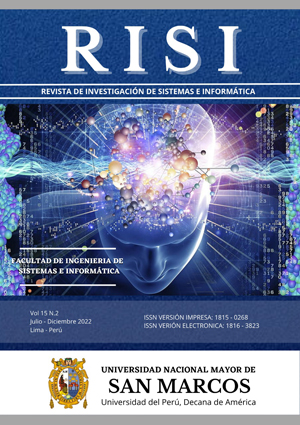Research on breast cancer prediction method based on machine learning
DOI:
https://doi.org/10.15381/risi.v15i2.23402Keywords:
decision tree, K-Nearest neighbors, naïve bayes, random forest, multi-layer perceptron and logistic regressionAbstract
Every year, the number of deaths increases extremely due to breast cancer. In 2020, the World Health Organization reported that 25% of women were diagnosed with breast cancer. In Peru, breast cancer was the main cause of death from cancer, where 5 women die from this disease every day. Early detection of breast cancer is facilitated by computerized detection and diagnostic (CAD) technologies, which can help people live longer lives. This article seeks to analyze multiple machine learning models to identify breast cancer. For this, we work with two Wisconsin databases donated by Dr. William H. Wolberg, the first set of databases is from 1995 and the second is from 1992, both reports are based on their clinical cases. The main objective of this work is to take advantage of the latest developments in CAD systems and related methodologies for predictions, Decision Tree models, K-Nearest Neighbors (K-NN), Naive Bayes (NB), Logistic Regression, Support Vector Machine, Multi-layer Perceptron and Random Forest were used. When the results are compared, it is found that for the database of the year 1995, the Multi-layer Perceptron algorithm offers the best results, achieving an accuracy of 97.20% and for the second database of 1992, the algorithm that best predicts is the Support Vector Machine with an accuracy of 97.20%.
Downloads
Downloads
Published
Issue
Section
License
Copyright (c) 2022 Jhelly Reynaluz Pérez Núñez

This work is licensed under a Creative Commons Attribution 4.0 International License.
AUTHORS RETAIN THEIR RIGHTS:
a. Authors retain their trade mark rights and patent, and also on any process or procedure described in the article.
b. Authors retain their right to share, copy, distribute, perform and publicly communicate their article (eg, to place their article in an institutional repository or publish it in a book), with an acknowledgment of its initial publication in the Revista de investigación de Sistemas e Informática.
c. Authors retain theirs right to make a subsequent publication of their work, to use the article or any part thereof (eg a compilation of his papers, lecture notes, thesis, or a book), always indicating its initial publication in the Revista de investigación de Sistemas e Informática (the originator of the work, journal, volume, number and date).


